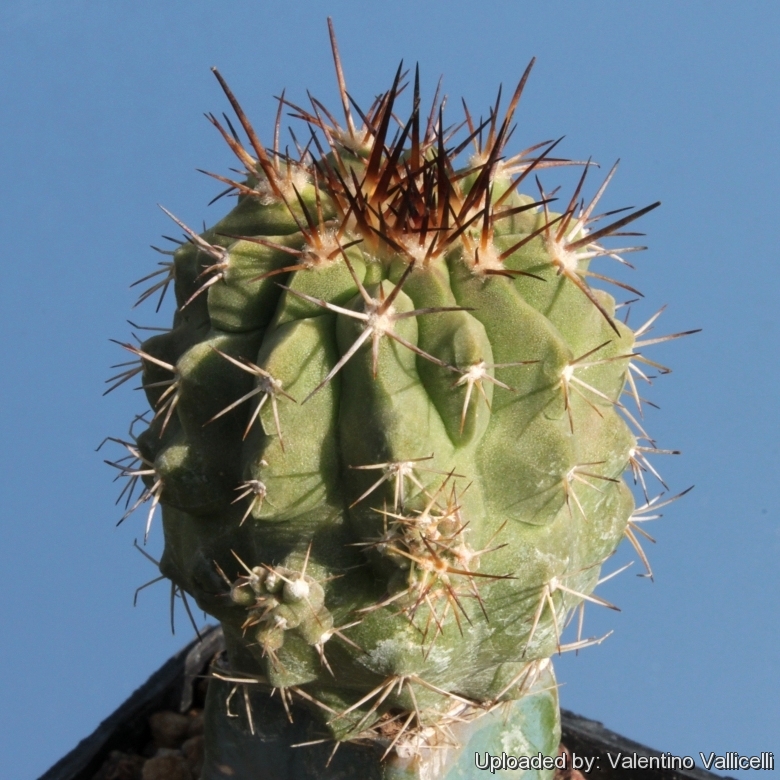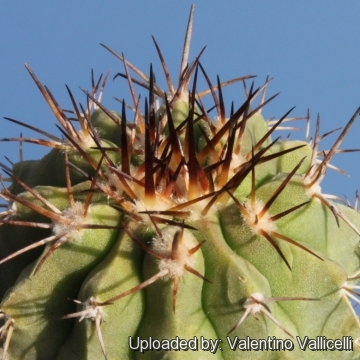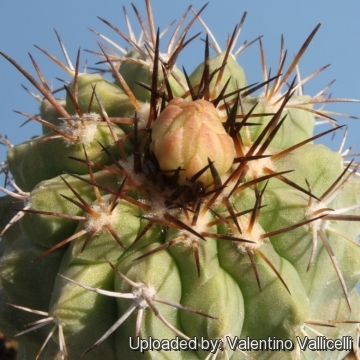= Copiapoa eremophila F.Ritter
Kakteen Südamerika 3: 1104 (1980).
Accepted Scientific Name: Copiapoa haseltoniana Backeb.
Descr. Cact. Nov. 33 (1957). Backeb.

Copiapoa cinerea var. eremophila (Copiapoa eremophila) Photo by: Valentino Vallicelli
Origin and Habitat: Quebrada Paposo, Paposo, Antofagasta Region II, Chile
Altitude: 600 to1000 metres above sea level.
Habitat: It grows in a very dry area near the cost in the border of desert. Plants in nature are often covered dust. There were several lilies and other wild flowers that cheered up the otherwise grey hill side. At times this region is dominated by geophytes (like lilies and other wild flowers), which can cover expanses of the desert spectacularly cheering up the otherwise grey hill sides.
Synonyms:
See all synonyms of Copiapoa haseltoniana
back
Accepted name in llifle Database:Copiapoa haseltoniana Backeb.Descr. Cact. Nov. 33 (1957).Synonymy: 17
back
Description: Copiapoa eremophilaSN|1339]]SN|1364]] is one of the controversial geographical forms of the very variable Copiapoa haseltonianaSN|1344]]SN|1339]] similar (if not the same) as Copiapoa giganteaSN|1339]]SN|1344]]. It is a densely spined form with very distinctive yellow-brown spines, later almost black found only on the high altitude range of the species. However apart for the spines it look very similar to other varieties of Copiapoa haseltonianaSN|1364]]SN|1339]] which are linked one to each others by populations of plants with intermediate characteristics. Nowadays all them are thought to belong to a unique polymorphic species. Such variations has led to establishment of several unnecessary names for this species.
Habit: It is a large sized often elongated and columnar plant slowly branching from the base, forming large, open clumps with (usually) few individual stems.
Stem: Globose to cylindrical, up to 1 m high, 20-30 cm across, pale olive-green, grey-green or ash-grey to silvery-blue when old, the apex is very spiny, covered with reddish, orangish or yellowish-brown wool. The whitish-grey coloration is a waxy coating presumably to prevent desiccation in it's extremely dry environment. In cultivation the white waxy bloom is often not produced, revealing a brownish epidermis.
Ribs: 14-22(-37), rounded, broad, obtuse, wavy, almost straight, thickened at areoles (tuberculate), becoming flattened. The ribs in the younger specimen have very geometric and conspicuous tubercles, typically with a hexagonal base.
Areoles: Up to 18 mm in diameter, orangish, fading in grey as they become older.
Radial spines: Up to 7, about 1-2 (or more) cm long, hard, horny-yellow to brown coloured, later brown-black, terete, tipped darker, spreading, straight or slightly curved.
Central spine: 0-1(-2) similar in colouration.
Flowers: Yellow funnelform, 1,5 to 2,5 cm in diameter. The Ovary is naked; it needs a lot of sunlight to bloom, so it's pretty rare to have blossoms when in cultivation in greenhouses.
Fruit: 1,5 to 2 cm long.
Seeds: Black and shining.
Bibliography: Major references and further lectures
1) Graham Charles “Copiapoa” Cirio Pub. Services, 1999
2) Edward Anderson “The Cactus family” Timber Press, Incorporated, 2001
3) Riha & Subik. “The illustrated encyclopedia of cacti and other succulents” (edited by G. & K.A. Beckett) 1981
4) James Cullen, Sabina G. Knees, H. Suzanne Cubey “The European Garden Flora Flowering Plants: A Manual for the Identification of Plants Cultivated in Europe, Both Out-of-Doors and Under Glass” Cambridge University Press, 11/ago/2011
5) Clive Innes “Complete Handbook of Cacti and Succulents” Van Nostrand Reinhold Company, 01/Dec/1981
6) David R Hunt; Nigel P Taylor; Graham Charles; International Cactaceae Systematics Group. "The New Cactus Lexicon" dh books, 2006
7) N. L. Britton, J. N. Rose “The Cactaceae. Descriptions and Illustrations of Plants of the Cactus Family.” Volume 4, The Carnegie Institution of Washington, Washington 1923
8) F.Ritter “Kakteen Südamerika” 3: 1072 1980
 Copiapoa cinerea var. eremophila (Copiapoa eremophila) Photo by: Valentino Vallicelli
Copiapoa cinerea var. eremophila (Copiapoa eremophila) Photo by: Valentino Vallicelli Copiapoa cinerea var. eremophila (Copiapoa eremophila) Photo by: Valentino Vallicelli
Copiapoa cinerea var. eremophila (Copiapoa eremophila) Photo by: Valentino VallicelliCultivation and Propagation: Considering that Copiapoa eremophilaSN|1364]]SN|1364]] comes from a habitat with an extremely arid climate, they are remarkably tolerant of pot culture, but susceptible to overwatering. They requires also an appropriate air circulation. Copiapoas are summer grower species easy to cultivate.
Growth rate: This is a slow growing cactus kept for the beauty of its form that will make clumps given the best conditions.
Soils: It likes very coarse mineral cactus mix soil, but can become too elongated if compost is too rich.
Repotting: Use pot with good drainage.
Watering: It requires light but regular waterings in summer, but let the soil mix dry between waterings, but do not overwater (Rot prone), it must be strictly kept dry throughout the winter quiescent period since it is very sensitive to any moisture excesses keep dry in winter.
Fertilization: Feed with a high potassium fertilizer in summer.
Hardiness: Not highly tolerant of a great deal of frost.They need to be kept in a cool place during winter rest and are resistant to light frost if kept on the dry side prior to, and during, cold weather ( they are hardy to -2 C ° C short periods). However some warmth throughout the year will increase the grower's success (minimum 5° to 10°C during rest season).
Exposition: Requires full sun or light shade and careful watering to keep plant compact with strong coloured spines. Tends to bronze in strong light, which encourages flowering and heavy spine production. Light shadow my be useful in the hottest summer days.
Uses: It is an excellent plant for container growing. It always looks good and stays small. It look fine in a cold greenhouse and frame or outdoor in a rockery.
Pests & diseases: It may be attractive to a variety of insects, but plants in good condition should be nearly pest-free, particularly if they are grown in a mineral potting-mix, with good exposure and ventilation. Nonetheless, there are several pests to watch for:
- Red spiders: Red spiders may be effectively rubbed up by watering the infested plants from above.
- Mealy bugs: Mealy bugs occasionally develop aerial into the new growth among the wool with disfiguring results, but the worst types develop underground on the roots and are invisible except by their effects.
- Sciara Flies: Sciara flies are one of the major problems for seedlings. It is a good practice to mulch your seedlings with a layer of grit, which will strongly discourage the flies.
- Scales: Scales are rarely a problem. It is wise to treat your whole collection with a systemic insecticide twice a year in spring and autumn.
- Rot: Rot is only a minor problem with cacti if the plants are watered and “aired” correctly. If they are not, fungicides won't help all that much. To prevent rottenness it is also advisable to surround its root neck by very rough sand or grit, this help a fast water drainage.
Propagation: Seeds (or offsets if available), Grafting is often used to speed growth rate and to create a back-up to plants in collection. Seeds germinate in 7-14 days at 21-27° C in spring, remove gradually the glass cover as soon the plants will be well rooted (ca 1-2 weeks) and keep ventilated, no full sun for young plants!












